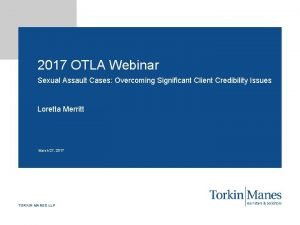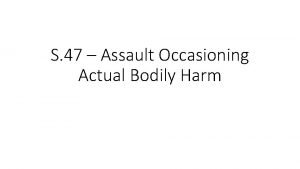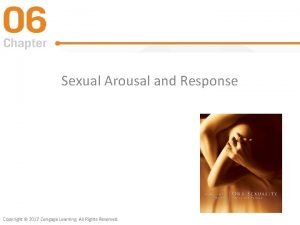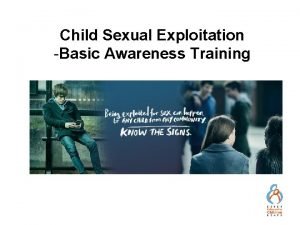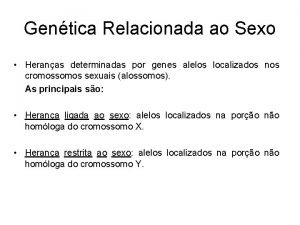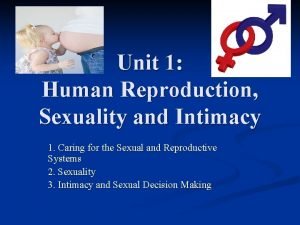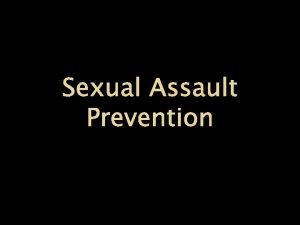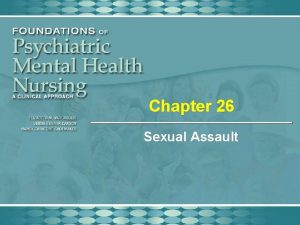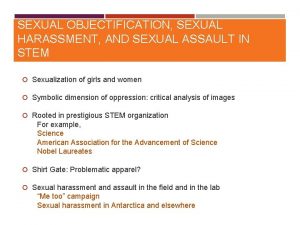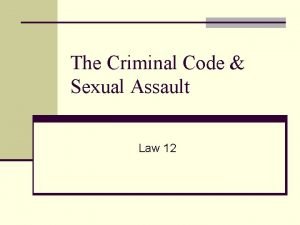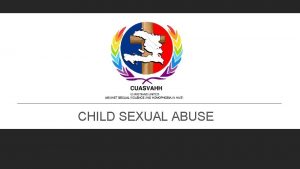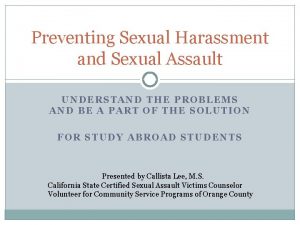Sexual Assault Sexual Assault Sexual assault is an

































- Slides: 33

Sexual Assault

Sexual Assault Sexual assault is an intentional act involving sexual organ. It includes acts like insertion of foreign objects into the genitals, forced removal of clothing, forcing someone to engage in sexual acts or positions, forcing someone to watch sexual acts. Sexual assault is a crime of violence and aggression. It encompasses a continuum of sexual activity that ranges from sexual compulsion to contact abuse (unwanted kissing, touching, or fondling) to forcible rape. Sexual assault of children and adult women is o The fastest growing, o Most frequently committed, and o Most underreported crime

• Sexual assault includes genital, or anal penetration by a part of the accused's body or by an object. • Only 30% of rapes are reported to the police, and 50% of rape victims tell no one. • The very young, elderly, & physically or developmentally disabled are particularly vulnerable to sexual assault. • Sexual assault occurs in all age, racial-ethnic, and socioeconomic groups.

Prevalence of rapes in different age groups Age of victims <11 yrs 11 -17 yrs 18 -24 yrs 25 -30 yrs >30 yrs prevalence 29% 32% 22% 7% 6%

Types of rape v. Acquaintance rape: refers to those sexual assaults committed by someone known to the victim. More than 75% of adolescent rapes are committed by an acquaintance of the victim v. Incest rape: When the acquaintance is a family member, including steprelatives and parental figures living in the home. v. Date rape: When the forced or unwanted sexual activity occurs in the context of a dating relationship. v. Statutory rape: refers to sexual intercourse with a female under an age specified by state law (ranging from 14– 18 years of age). v. Marital rape: is defined as forced coitus or related sexual acts within a marital relationship without the consent of a partner.

Types of assailants & its frequency Types of assailants strangers husbands/ex-husbands Boyfriends/ex-boyfriends Fathers/step fathers Other relatives Other non relatives frequency 20 -25% 9% 10% 11% 16% 29%

Types of rapists • Opportunist rapists: (30%) exhibit no anger toward the women they assault and usually use little or no force. • Anger rapists : (40%) usually batter the survivor and use more physical force than is necessary to overpower her. • Power rapists: (25%) do not intend to physically harm their victim but rather to possess or control her to gain sexual gratification. • Sadistic rapists: (5%) become sexually excited by inflicting pain on their victim.

Clinical Presentation • The majority of rape victims who come to emergency rooms do not openly admit to having been sexually assaulted. • A "rape-trauma" syndrome often occurs after a sexual assault. • The initial response (acute phase) may last for hours or days and is characterized by a distortion or paralysis of the individual's coping mechanisms.

• The next phase (delayed phase) may occur months or years after the sexual assault and is characterized by qchronic anxiety q feelings of vulnerability q loss of control q and self-blame.

Long-term reactions include: o o o o o Anxiety Nightmares Flashbacks Catastrophic fantasies Feelings of alienation and isolation Sexual dysfunction Psychological distress Mistrust of others Phobias, depression, hostility, and somatic symptoms

Impact of sexual assault on the survivors o >50% of rape victims experience difficulty in reestablishing sexual and emotional relationships with spouses or boyfriends. o 33 -50% of victims report suicidal ideation; suicide attempts in 20% rape victims who do not seek treatment. o Women with prior victimization histories have more severe sequela. o Up to 40% of victims sustain injuries. o Approximately 1% of the injuries require hospitalization & major operative repair, & 0. 1% are fatal. o Nearly 50% of the survivors lose their jobs or are forced to quit in the year following the rape, and 50% change their place of residency

Evaluation of the victim of Sexual Assault v. Component of the complete medical evaluation of the victim of sexual assault include: ØDetailed medical history ØComplete physical examination ØAll necessary laboratory investigations and collection of forensic evidence ØProvision of a detailed medical confirmation as requested by the justice and legal departments

• Informed consent must be obtained prior to examining a sexual assault victim. • A careful history and physical examination should be performed in the presence of a chaperon or victim advocate. • The patient should be asked to state in her own words what happened, and to identify or describe her attacker, if possible.

The history should include: last menstrual period, Contraceptive use, Preexisting pregnancy and infection, Date & time of last consensual intercourse & number of partner before the assault. • Currently, whether the patient has eaten, drunk, bathed, douched, voided, or defecated. • •

A detailed description of the sexual assault like: The place, time, date of the assault Number of assailants Use of drugs or alcohol in relation to the assault Loss of consciousness Use of weapons Threats, and restraints; and Any physical injuries. Whether vaginal, or anal contact or penetration occurred; Insertion of a foreign object with a description of the object; Whether the assailant used condom; and Whethere were other possible sites of ejaculation, such as the hands, clothes, or hair of the survivor. Ø Psychological reactions such as Depression, withdrawal, change of appetite or sleep patterns, shame and a feeling of guilt. ü ü ü

Physical examination of the sexual assault victim General appearance: • Height/weight for children and if appropriate for adult as well • General nutritional status and appearance including mood • Signs of neglect or physical abuse • Obvious functional impairments Assess ability to consent: i. e. drunk, mentally retarded etc When you feel that patient is ‘slow’, ‘can’t quite hold a normal conversation’, it is advisable to seek expert opinion from a psychiatrist/clinical psychologist In children, describe whether child is anxious, fearful, tearful, happy, withdrawn.

Examination contd. Sexual maturity rating: Use the tanner staging of sexual maturity 1 -5 and assess as ‘pre-pubertal’, ‘pubertal’ and ‘mature’. This is significant in a child victim to assess the age and maturity as well. The physical examination serves to detect, evaluate, and treat all injuries and to collect forensic evidence The nature, size, and location of all injuries should be carefully documented, using photographs or body charts if possible. Non genital injuries occur in 20% to 50% of all rapes, so it is important to examine the entire body.

Genital examination q. Positioning for examination: • For the adult female victim, the dorsal lithotomy position. • For the child, frog leg position. • For male assault victims, left lateral position. • Sedation or examination under anesthesia for the very agitated and uncooperative child.

Describe any change noticed on each of the external and internal genital examination in a stepwise fashion: o Labia majora o Labia minora o Urethra o Fossa navicularis o Posterior fourchette o Perineum o Hymen

The most common genital findings are erythema and small tears of the vulva, perineum, and introitus. There may be bleeding, mucosal tears, erythema, or a hematoma noted around the rectum if penetration has occurred. A Foley catheter, placed in the distal vaginal vault and then inflated, allows for full visualization of hymenal injuries Forensic evidence and laboratory investigation Vaginal swab for spermatozoa Take a swab for semen before doing the internal/speculum examination in the adult; Avoid KY jelly, antiseptic solutions as it interferes with the forensic analysis.

Laboratory tests § Motile spermatozoa with in 6 hrsin the vaginal canal § Duration of dead immotile spermatozoa recovery • Mouth 12 -14 hrs • Vagina 6 days • Anus 3 days • Mouth 12 -14 hrs • Cervix 7 -10 days

Laboratory contd. Screen for sexually transmissible infections • Grams stain for intra cellular diplococci (ICDC) • Saline mount for Trichomonas Vaginalis • Hepatitis B surface antigen • VDRL/RPR Baseline pregnancy test to confirm or exclude pregnancy Testing for HIV should be done at initial encounter, at three months and six months for a victim who is negative to HIV test at initial encounter

Treatment Plan ØPurpose of management • To prevent acute life threatening conditions like suicide • To identify and treat acute genital injury • To give prophylactic management for sexual transmitted infections and prevention of pregnancy • To provide evidences of sexual assault • To provide psychological care or refer as appropriate

Appropriate medical or surgical treatment for acute injuries. • Clean any tears, cuts and abrasions and remove dirt, faeces, and dead or damaged tissue. • Suture clean wounds within 24 hours. • Do not suture very dirty wounds. • If there are major contaminated wounds, consider giving appropriate antibiotics and pain relief.

Emergency contraception a. Progestin only Pills Levonorgesrel 0. 75 mg one tab, repeat after 12 hours eg. Postinor Levonorgesrel 0. 0375 mg containing oral contraceptives 20 tabs per dose 12 hours apart eg. Ovrette b. Combined oral contraceptive pills with High dose of estrogen (50μg) E. g. Ovral: 2 -tabs 12 hours apart. Combined oral contraceptive pills with low dose of estrogen (30μg) E. g. Nordette 4 tabs 12 hours apart c. IUCD

Prophylaxis for STIs: Adults All new cases of abuse should be given empirical antimicrobial therapy for chlamydia, gonococcus and trichomonal infection Ceftriaxone 125 mg IM in single dose, plus Metronidazole 2 gm orally in single dose, plus Doxycycline 100 mg orally two times a day for 7 days. Children or pre-pubertal cases Erythromycin 30 -50 mg/kg/day in divided doses every 6 hours. Hepatitis B Prophylaxis Hepatitis B vaccine should be administered to victims of sexual assault at the time of initial examination and should be repeated one month and 6 month after the first dose

Tetanus • TAT 3000 -6000 units IM after skin test Post Exposure Prophylaxis (PEP) ØIf the HIV status of the assailant is not known, assume that the assailant is infected & start PEP Ø Risk of HIV exposure increases if there is o More than one assailant o Anal assault o Damaged or torn skin

• Provide appropriate counseling and psychological support and referral The following options should be clearly explained for assaulted victims becoming pregnant: • Ante Natal Care • Adoption and foster centers • Abortion services

Legal obligations of sexual assault • Record events accurately • Document injury with diagrams • Collect sample to be sent forensic examination whenever possible • Provide medico legal certificate using reporting format

Follow up evaluation At Two weeks • Screen for pregnancy and manage accordingly • Check whether the full course of antibiotics has been taken • Screen for STI and treat • Asses emotional and mental status, treat or refer as appropriate If PEP provided: o Evaluate for adherence and side effects o Make sure the survivor has enough medication for four weeks o Reevaluate at six weeks

12 weeks later • Screen for pregnancy and manage accordingly • Screen for STI and treat • Asses emotional status • Repeat serum test for RPR/TPHA • Repeat serum test for HIV at 3 and 6 months • Asses emotional and mental status, treat or refer as appropriate.

• Reading assignment • Harmfull traditional practices

Thank you
 Wasac
Wasac Robert allison sexual assault
Robert allison sexual assault Sexual assault expert witness
Sexual assault expert witness Koko the gorilla sexual assault
Koko the gorilla sexual assault Tca 40-7-103
Tca 40-7-103 Difference between abh and gbh
Difference between abh and gbh Actus reus of battery
Actus reus of battery Assault position
Assault position Tadpole diagram air assault
Tadpole diagram air assault Assault vs battery examples
Assault vs battery examples Obscene and indecent articles ordinance
Obscene and indecent articles ordinance Isrr icd10
Isrr icd10 Assault vs battery
Assault vs battery The assault cycle is used to
The assault cycle is used to Connecting the concepts sexual reproduction
Connecting the concepts sexual reproduction Metaphase ii
Metaphase ii Sensirial
Sensirial The disadvantages of sexual reproduction
The disadvantages of sexual reproduction Sexual health and relationships education scotland
Sexual health and relationships education scotland Chapter 10 sexual reproduction and genetics
Chapter 10 sexual reproduction and genetics Arousal cycle
Arousal cycle Sexual
Sexual Definition of sexual exploitation
Definition of sexual exploitation Hare lynx
Hare lynx Sexual reproduction and genetics section 1 meiosis
Sexual reproduction and genetics section 1 meiosis Herança recessiva ligada ao x
Herança recessiva ligada ao x Sexual perversion
Sexual perversion A sexual reproduction in humans
A sexual reproduction in humans Apetite sexual
Apetite sexual Budding asexual reproduction
Budding asexual reproduction What are sexual fantasy
What are sexual fantasy Primary sexual characteristics
Primary sexual characteristics What is gender transformative approach
What is gender transformative approach The westermarck effect
The westermarck effect



